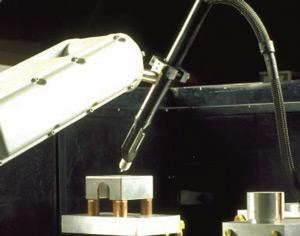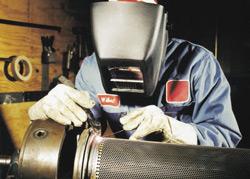- FMA
- The Fabricator
- FABTECH
- Canadian Metalworking
The Fundamentals of Plasma Welding
For those who choose a vocation in plasma welding, learning and practicing the fundamentals of the trade never stop. A dangerous profession, welding requires strict adherence to safety protocols and continuing education throughout one’s career. So for those who need a refresher course, let’s get back to the basics.
The three states of matter, are solid, liquid, and gas, right? Wrong. Your sixth-grade science teacher didn’t tell you the whole truth. Consider the fourth state of matter: plasma.
Plasma welding is a superheating of gas that becomes highly conductive and, in welding, allows for the transfer of an electric arc. When you pass a gas through this electric arc, it breaks the gas down and forms what is called a plasma stream.
Because the temperature of a plasma flame can reach as high as 30,000 degrees F, safety is always of utmost importance. By understanding the purpose and choices in plasma welding, professionals will have a clear guideline to the proper operation and applications for the trade.
Plasma Welding - Then and Now
Dr. R. M. Gage is credited with the introduction of plasma into the welding industry in 1955, and in the 1960s it was integrated into microplasma and high-current applications. The use of plasma welding has increased, primarily for automated welding (80 to 85 percent).
Similar in process to gas tungsten arc welding, plasma welding offers the added benefit of not needing high frequency for arc start, which can interfere with computerized equipment. This advantage suits plasma for automated welding in which high-volume, repeatable, and short-duration welds are needed.
The Energy Source
The plasma gas serves as the energy source during plasma welding. Plasma gases go through the torch, around the electrode, and through the orifice. Plasma gases include argon and argon/hydrogen, but pure argon is by far the most commonly used, followed by argon/hydrogen.
• Argon: Utilized 98 percent of the time for plasma welding, argon breaks down and creates a plasma stream more easily than any other gas. This provides the best pilot arc and feather at the end of the torch for starting the welding arc. Additionally, argon is an inert gas, which means it does not contaminate or oxidize the base materials.
• Argon/Hydrogen: Consisting of 98 percent argon and 2 percent hydrogen, this mixture is recommended only for nickel-based materials such as stainless steel. The hydrogen content in argon produces a hotter arc and breaks up the surface oxides on the material being welded and also stabilizes the weld puddle. However, this gas is seldom used for the plasma, except in the case of welding thin materials at low amperage levels, because of its erosion effects on welding accessories. The extra heat produced by the hydrogen significantly shortens the life of the plasma tip.
Shielding Gas
The shielding gas flows on the outside of the tip and inside of the shielding cup. This protects the weld puddle from the atmosphere and ensures it does not oxidize. Argon is also the most commonly used gas for shielding, followed by argon/hydrogen and helium.

The pilot arc protects the tungsten electrode from contamination and is used in the initiation of the plasma welding arc.: Plasma arc welding is used to fuse a thin-gauge canister.
- Argon: Argon is the cheapest gas to use and is heavier than air, thus providing good shielding of the weld puddle, as well as good arc stability. It also allows for the best and longest pilot arc feather for the pilot arc. The better the feather, the better the welding arc will transfer to the part to be welded.
- Argon/Hydrogen: Consisting of 95 percent argon and 5 percent hydrogen, this gas is used for stainless steels and nickel-based alloys. By creating a hotter arc and in turn a hotter puddle, it narrows the weld bead and drives the penetration down in the base material, reducing surface tension of the puddle and allowing faster travel speed. In addition, it has a tendency to break up the surface oxides on the puddle, creating a more stable puddle and smoother flow.
- Helium: This gas is 25 percent hotter than argon and is used to weld aluminum, copper and copper alloys, and thick titanium. In these materials, heat is conducted throughout the metal very quickly. Helium’s extra heat provides an advantage by producing heat for the weld puddle faster than it is being transferred away. However, since it is lighter than air, helium floats away more rapidly and may require a gas trailer on the torch to ensure the shield gas stays over the weld puddle long enough for the puddle to cool.
Modes of Operation
Plasma welding has three different modes of operation that are determined based on the current, plasma gas flow rate, and orifice diameter. These are microplasma mode, high-current mode, and keyhole mode.
The microplasma mode, ranging from 0.1 to 15 amps, allows the welder to operate with a longer arc length in relation to GTAW and no possibility of touching the electrode to the work. At low welding currents, the arc remains stable, making it suitable for welding very thin materials in delicate situations. The microplasma mode can be used for tool and die work as well as mold repair.
The high-current mode, also known as melt-in mode, typically ranges from 15 to 400 amps and is used for precision and high-weld-quality operations. It also is used in overlay applications such as hard surfacing.
The protected electrode inside the torch improves welding geometry and penetration control. This mode also provides a reliable arc transfer and arc stability. However, this technique only can be used in conjunction with larger orifices and precise plasma gas flow rate control to avoid burnout of the plasma tip.
The tungsten in the torch can be set in two ways in this mode. In most cases, the electrode is set flush with the end of the tip. This gives a soft arc much like a GTAW arc. The second way is to recess the tungsten inside the plasma tip. This can vary in distance but is not to exceed the recommended setting in the book. Recessing the tip provides more of a column-type arc.
In keyhole mode, from 100 amps and higher, the tungsten is recessed in the tip and the current level and plasma gas flow are increased.
This mode generates a powerful plasma arc, very similar to a laser beam. During welding, the plasma arc pierces through the material, producing a keyhole through the part, with the molten weld pool flowing around the keyhole to form the weld bead. This provides complete penetration through the thickness of the part in one pass. In very thick material, a joint design is needed to reduce the thickness of the material, and multiple passes in the nonkeyhole mode are needed to fill the joint.
Sustainability
Plasma welding’s sustained success will be determined by the diligence of the professionals who use it to adhere to best guidelines for usage and safety protocols. Its versatility, quality, and control has helped this technology move into a variety of industries, including aerospace, automotive, and railway repair operations.
For more information, visit www.thermadyne.com.
Problem-free Torch Setup
- Prepurge before starting the pilot arc to prolong long torch life. Turn the pilot arc off first, and allow the torch to purge before turning the machine off to keep the hot electrode from oxidizing.
- Always check that the gas distributor is installed correctly.
- Ensure that the correct tip and tungsten for amperage are selected.
- Remember that maximum amperage rating is achieved using a flush tungsten setting.
- Set the plasma gas flow rate as high as possible without disturbing the puddle. This will prevent the tip of the torch from starving of plasma gas and burning the tip out faster.
- When installing parts, confirm they are not contaminated with body oils or soiled surfaces.
- Periodically evaluate the condition of the ground clamping surface to avoid losing amperage.
subscribe now


Keep up to date with the latest news, events, and technology for all things metal from our pair of monthly magazines written specifically for Canadian manufacturers!
Start Your Free Subscription- Trending Articles
- Industry Events
MME Winnipeg
- April 30, 2024
- Winnipeg, ON Canada
CTMA Economic Uncertainty: Helping You Navigate Windsor Seminar
- April 30, 2024
- Windsor, ON Canada
CTMA Economic Uncertainty: Helping You Navigate Kitchener Seminar
- May 2, 2024
- Kitchener, ON Canada
Automate 2024
- May 6 - 9, 2024
- Chicago, IL
ANCA Open House
- May 7 - 8, 2024
- Wixom, MI
















